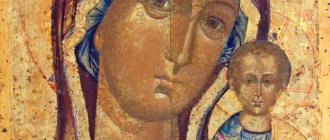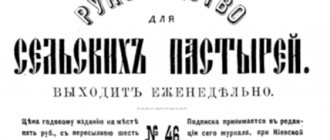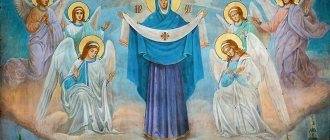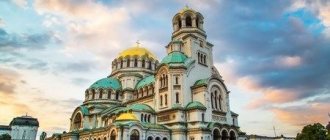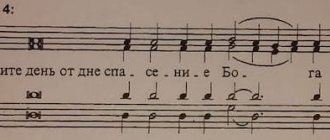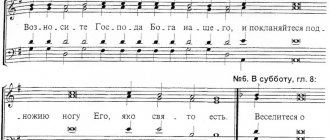Greatness - what is it?
What is the glorification of the Mother of God or a saint? The term “magnification” comes from the word “magnify”, that is, to magnify, glorify, glorify, give praise. In Orthodoxy, magnification is a short solemn prayer chant with which the Lord, the Mother of God, an angel or a saint is glorified. There are also similar chants in honor of Christian holidays.
Blessed Virgin Mary (Byzantine mosaic)
The Troparion of the Intercession of the Blessed Virgin Mary is read on October 14
One of the most popular troparions to the Mother of God is the Troparion of the Intercession of the Blessed Virgin Mary. It is read in front of the corresponding icon on October 14.
Before such an icon the troparion of the Intercession of the Blessed Virgin Mary is read
October 14 is the date when the troparion of the Feast of the Intercession is read.
Troparion to the Protection of the Blessed Virgin Mary
Troparion, Tone 3:
Today, faithful people, we brightly celebrate, overshadowed by Your coming, O Mother of God, and looking to Your most pure image, we tenderly say: cover us with Your honorable Protection, and deliver us from all evil, begging Your Son Christ our God to save our souls.
Kontakion, Tone 4:
The Virgin stands today in the Church, and from the faces of the saints she invisibly prays to God for us: the angels and the bishops bow down, the apostles and the prophets rejoice: for for our sake the Mother of God prays to the Eternal God.
By leaving a comment, you accept the user agreement
Features of the glorification genre
Works of this genre of church hymnography, as a rule, begin with the word “Glorify.” Only the general glorification of the Mother of God and the glorification of the monk (holy monk) have a different beginning. In the latter case, the chant begins with the word “We please.” Further, it is explained in poetic language why the sacred person is revered by Orthodox Christians. Her main spiritual “merits” are also mentioned.
There are generally accepted established texts of magnification for various categories of personalities revered in Christianity. For example, magnification of angels, prophets, apostles, saints, martyrs, etc. In honor of the Lord, the Mother of God, as well as the most famous saints, there are several variants of magnification. Usually they differ slightly from the standard ones.
History of the glorification genre
The origins of the genre of majesty are seen in the refrains to the 17th kathisma of the Psalter, sounded at the service of Holy Saturday. From historical documents it is known that these refrains were used in the Jerusalem church as early as the 8th century. Later, full-fledged cycles of similar refrains arose for other holiday services. Thus, in the 13th century, similar choruses for the Dormition of the Mother of God appeared. And in the 14th century - on the Beheading of John the Baptist.
In the 13th century, through the works of the Byzantine church leader Nikephoros Blemmides, a special genre of church hymnography arose - the chosen psalm. This is the name given to a selection of lines from Old Testament works, which is used to glorify New Testament personalities and holidays. Initially, the word “Alleluia,” which translates as “Praise God,” was used as a refrain to selected psalms. However, this exclamation was soon replaced by other refrains. They did not take root in the Slavic Orthodox Churches, so they were replaced by their own choruses of magnificence.
At the end of the 18th century, the first collection of greatnesses was published. Solemn chants, including the glorification of the Mother of God, were arranged in the collection in the order in which they are used in the church year.
Sretensky Monthly
Hieromartyr Hilarion (Troitsky), Archbishop of Vereya, is an outstanding hierarch and one of the greatest church figures of the 20th century, a scientist and church writer, a hero in spirit and body, a wonderful soul, a man endowed by the Lord with extraordinary theological talents, an unsurpassed orator, who laid down his life for the Church of Christ .
The childhood of the future ruler
Archbishop Hilarion (in the world Vladimir Alekseevich Troitsky) was born on September 13, 1886 in the village of Lipitsy, Kashira district, Tula province, in the family of the parish priest Alexy Troitsky. The grandfather and father of the future Bishop Hilarion served in the same church, consecrated in honor of the Feast of the Annunciation of the Most Holy Theotokos.
In addition to the eldest, Vladimir, four more children grew up in the Troitsky family: Dmitry, Alexey, Olga and Sofia. All three Trinity brothers became clergy, fighters against the Renovationist schism and confessors. Dmitry, later Archbishop Daniel of Bryansk, died young from typhus: his health, undermined in northern exile, took its toll. He was notified of the day of his death by the appearance of angels, and before his death he received unction and received Holy Communion. Alexey became a priest, took the place of his parent who died in 1917, and was later subjected to repression and was shot at the Butovo training ground near Moscow.
After the untimely death of their mother, her unmarried sister, a teacher at a parochial school, took over the care of the Trinity children. Having lost his mother in childhood, Vladimir experienced this loss for a long time and acutely. Already as an adult, he wrote: “...I lost my mother almost twenty years ago. At that time I felt my orphanhood, so to speak, practically, in the everyday sense, and now sometimes I painfully feel my orphanhood mystically.” Perhaps for this reason, since childhood, the bishop had a particularly warm feeling for the Mother of God: “The Most Holy Theotokos is our common Mother.”
Having mastered reading and writing early, Vladimir, already at the age of five, lovingly participates in divine services, reading the hours and the Six Psalms. He later recalled his childhood as follows: “Blessed be the name of the Lord and for the fact that I did not have a pampered upbringing in my childhood, growing up among the meadows, fields and forests of my Motherland in the gracious simplicity of working life, why even if I am ashamed to ask, I can dig (cf. Luke 16:3), and these hands can serve my demand (cf. Acts 20:34). I thank God, who from the days of childhood opened my mind, put into it a thirst for knowledge and led me through not just any other school, but through a spiritual school.”
Youth and study
At ten years old, the boy enters the Tula Theological School, then continues his education at the Tula Theological Seminary and, finally, enters the Moscow Theological Academy on public account. He studies with constant success, and he is even awarded a private scholarship named after Professor V.D. Kudryavtseva-Platonov.
In 1910, Vladimir Alekseevich graduated from the academy with a candidate of theology degree. For his essay, he was awarded the Metropolitan Joseph Prize and was retained at the academy for teaching. Former MDA student S. Volkov recalled the lectures of the young teacher Troitsky: “He could not calmly narrate... but had to burn, ignite his listeners, argue, polemicize, prove and refute... He was never just a theorist: he was a man of action, always connecting theory with practice."
The young theologian's master's work was recognized as the best in the 1912/1913 academic year, and Vladimir Alekseevich was awarded the Metropolitan Macarius Prize of Moscow. He was also confirmed as a master of theology and as an associate professor at the Moscow Theological Academy. He himself wrote about himself: “For me there is only the Lavra and the Academy, and I exist for the Academy.”
Monastic tonsure
On March 28, 1913, in the Paraclete Hermitage of the Trinity-Sergius Lavra, Vladimir Troitsky took monastic vows with the name Hilarion, in honor of the Venerable Hilarion the New. After tonsure, he experiences a previously unprecedented spiritual upsurge: “I spent five days in the church in spiritual joy... In the past days of my monasticism, I experienced mainly a feeling of joy and spiritual peace... Yes, things are the same, but I feel a significant change in myself. I would like to believe that this is the effect of a special grace bestowed on a monk... Don’t feel sorry, but rejoice, because now I am rejoicing. What does Hilarion mean? Funny".
New and difficult obedience
On April 11, 1913, on Maundy Thursday, Monk Hilarion was ordained a hierodeacon, at the end of May he was appointed to the post of inspector of the MDA, and a few days later he was ordained a hieromonk. He accepts this new and difficult church obedience with monastic humility: “I don’t complain, because a monk is a church thing. He has no personal life - he is alone. Wherever they put you, take it and work... Thank God for everything!”
On July 5, 1913, Father Hilarion was elevated to the rank of archimandrite. He became the youngest archimandrite and professor at the academy for his time. In his life, a five-year period of his inspection at the MDA begins, full of work and worries: preparing and delivering lectures, reviewing educational and scientific essays, participating in worship, participating in meetings of the Academy Council, in various academic acts and events, publishing articles in church journals. While still a student and graduate student, he headed the publishing department of the Pastoral and Educational Brotherhood at the MDA, was involved in the publication and distribution of leaflets with spiritual and moral content for the people, and participated in the student care of a school-orphanage for children.
At the Local Council
At the Local Council of the Russian Orthodox Church in 1917–1918, Archimandrite Hilarion not only acted as an active supporter of the restoration of the patriarchate, but also significantly contributed to the positive resolution of this controversial issue for many at the Council. In the years following the Council, Archimandrite Hilarion became the suffragan bishop of the Patriarch, one of his closest assistants, including in the fight against renovationism.
High church service
On March 10, 1919, Archimandrite Hilarion, without any serious charges, was imprisoned in Butyrka prison, where he remained for almost three months. After the liberation, on May 12/25, 1920, Patriarch of Moscow and All Rus' Tikhon consecrated 33-year-old Archimandrite Hilarion (Troitsky) as Bishop of Vereisky, vicar of the Moscow diocese. The appointed bishop in his speech expresses the consciousness of his unworthiness for such a high church service: “I was a sinful layman, I became a sinful monk, I became a sinful priest, but to be a sinful bishop - I tremble.” But he is accustomed to the obedience of the Church and responds with the words of Holy Scripture: “The will of the Lord be done” (Acts 21:14).
Abbot of Sretensky Monastery
Having become Bishop of Vereisky, Bishop Hilarion was appointed rector of the Sretensky Monastery. The first year of the bishopric is filled with divine services and preaching. In addition, in the fall of 1920 he suffered from typhus. The disease left a complication on the heart, which made itself felt in subsequent years.
N.P. Okunev, in his “Diary of a Muscovite,” recalled the services at the Sretensky Monastery during Great Lent in 1921: “Bishop Hilarion was attracted there, not by his magnificent hierarchal service, but by his participation in the services as an ordinary monk... Well! I'll tell you, and he sang! His voice is most pleasant, clear, sonorous, young (he is 35 years old), high. Tenor. He sang simply, not according to the notes, but so touchingly and sincerely that I, perhaps, have never heard such a wonderful performance in my entire life.” At the same time, the younger brother of Bishop Hilarion, Archimandrite Daniel, later Archbishop of Bryansk, became a canon in the Sretensky Monastery.
Arrest and exile
Already in September 1921, the bishop was arrested again for obtaining permission from the director of the Tretyakov Gallery to take the miraculous Vladimir Icon of the Mother of God to the Sretensky Monastery for the patronal feast, which caused a significant crowd of believers in the monastery. The ruler’s popularity among the people grew, but the hatred of the Soviet authorities also intensified.
In March 1922 - a new arrest and sentence: a year's exile in Arkhangelsk. The conditions in which the bishop was located were wretched, this was noted even in the records of the search that was carried out in his room. At this time, he shares in letters: “I am not at all interested in my personal fate, because the external situation is nothing important for me... But I cannot help but suffer and speak passionately, seeing and understanding the suffering of the Russian Church.”
"A real Russian saint"
On July 5, 1923, on the eve of the feast of the Vladimir Icon of the Mother of God, Bishop Hilarion, who had returned from exile, served an all-night vigil at the Sretensky Monastery, having previously performed the rite of consecration of the temple. The next day he will serve with the Patriarch at the liturgy and deliver a sermon in which he denounces the renovationist schism and calls those who have fallen away to repentance. The influence of the ruler on his contemporaries at this time was enormous; the renovationists themselves involuntarily began to respect him.
Anatoly Krasnov-Levitin, a memoirist and participant in the renovationist schism, wrote: “It was difficult to think of a better assistant for Patriarch Tikhon than Bishop Hilarion. A magnificent, fiery preacher who knew how to speak simply and emotionally, a zealous altar server, Bishop Hilarion enjoyed enormous popularity among the Moscow clergy and literally the adoration of the people. The very appearance: heroic height, blond beard, iconographic delicate facial features - impressed with its majesty, strict grace, and peculiar picturesqueness. “This is a real Russian saint,” the thought involuntarily came to everyone who saw Hilarion...
During these days, he talked with hundreds of priests, laity, monks and nuns, agreed with the parishes on the order of their joining the Patriarch, developed the order of repentance, and immediately received dozens of renovationists who came to the Patriarch with repentance. Thanks to the indomitable energy of this man, the church organization in Moscow was restored in two days.”
Soon after returning from exile, Bishop Hilarion was elevated to the rank of archbishop by His Holiness Patriarch Tikhon. The Bishop conducts successful debates with renovationists and atheists, including the leader of the renovationists Vvedensky and the People's Commissar of Education Lunacharsky. The authorities could not tolerate this success of the ruler, and on November 15, 1923, he was arrested again.
Solovki
His Holiness Tikhon’s request for the release of his closest assistant was rejected, and on December 7 of the same 1923, Bishop Hilarion was sentenced to three years’ imprisonment on Solovki.
In the camp, Vladyka retained his monastic non-covetousness, childish gentleness and simplicity. He easily gave everything that was asked of him. He never responded to any insults from those around him—he didn’t even seem to notice them. He was always calm and cheerful in spirit, and even if something was bothering him, he did not show it. He spoke equally calmly and respectfully with fellow clergymen, with students, with professors, and with criminals, of whom there were many on Solovki. There was nothing ostentatious about this: the bishop knew how to recognize the image of God in any person, and people responded to his kindness and mercy with sincere respect and love.
Protopresbyter Michael of Poland, who was on Solovki with the bishop, described him this way: “Archbishop Hilarion is a young, cheerful, comprehensively educated man, an excellent church preacher, orator and singer, a brilliant polemicist with atheists, always natural, sincere, open; wherever he appeared, he attracted everyone to him and enjoyed universal love.”
The new schismatic community organized by the authorities lacked authority in the eyes of Church members. To make up for this deficiency, an unsuccessful attempt was made to bring Archbishop Hilarion into the schism. For this purpose, he was transferred to a prison in Yaroslavl for conversations with the security officer Tuchkov, after which he was again sent to Solovki.
The path of the confessor of the faith of Christ
At the end of his term, the bishop was sentenced to a new exile to Kazakhstan. They were sent there in stages through transit prisons. At the stage, the bishop was robbed. Soon he contracted typhus and ended up in a Leningrad prison hospital. Here he was shaved, but the confessor of Christ already foresaw his imminent freedom in the Heavenly Church and in unconsciousness said: “Now I’m completely free, no one will take me...”.
On December 15/28, 1929, Bishop Hilarion departed to the Lord.
Metropolitan Seraphim (Chichagov), who then occupied the Leningrad See, asked for the body of the deceased bishop for burial. The body that was handed over was not recognized: a gray-haired, beardless old man with a shaved head, although he was only 43 years old. The funeral service took place in the Resurrection Cathedral of the Novodevichy Convent.
***
On July 24, 1998, the discovery of the relics of Bishop Hilarion took place. On May 10, 1999, at a solemn service in the Moscow Sretensky Monastery, where the holy relics were delivered from St. Petersburg the day before, Archbishop Hilarion (Troitsky) was glorified as a locally revered saint, and in 2000, at the Jubilee Council of Bishops of the Russian Orthodox Church, he was numbered among the host of holy new martyrs and Russian confessors for church-wide veneration.
The glorification of the Mother of God and saints in divine services
Magnifications are used in the services of some local Orthodox Churches. In Greek Orthodoxy the practice of singing hymns is absent. A similar term there refers to the choruses of some canons.
In the Russian Orthodox Church, magnifications are sung at matins on holidays following the polyeleos. Also, these solemn chants can be heard at the festive Divine Liturgy after the priest pronounces the dismissal (final blessing).
It is worth noting that greatnesses are often called “choruses.” This is due to the fact that they are used as refrains during the reading of the selected psalm. Magnifications can also be heard at prayer services, religious processions and during the transfer of holy relics. According to the Typikon (liturgical charter), the magnification is sung alternately by two choirs.
Hymns of such church genres as troparion, kontakion and magnification are often performed together, one after the other. Together they form a festive doxology. An Orthodox Christian can independently resort to it on the day of remembrance of a saint or holiday. Kontakia, magnification, as well as corresponding troparions to saints can be easily found in Orthodox prayer books and on thematic Internet sites.
Examples of greatness
Glorification of the Lord as Savior
We magnify Thee, the Only Begotten Son of God, Jesus Christ, who with all Thy wisdom in the beginning created and all-mercifully redeemed the fallen race from eternal death.
To the Lord in honor of His Image Not Made by Hands
We magnify Thee, Life-Giving Christ, and honor all the glorious imagination of Thy Most Pure Face.
The Greatness of the Virgin Mary
It is worthy to magnify Thee, the Mother of God, the Most Honest Cherub and the Most Glorious without comparison, the Seraphim.
Theotokos in honor of Her icon
We magnify You, Most Holy Virgin, God-chosen Youth, and honor Your holy image, which brings healing to all who come with faith.
Apostles Peter and Paul
We magnify you, Christ's apostles Peter and Paul, who enlightened the whole world with your teachings and brought everything to Christ.
Saint Nicholas the Wonderworker
We magnify you, Father Nicholas, and honor your holy memory, for you pray for us to Christ our God.
The general troparion of the Virgin Mary is the most famous
Troparion, kontakion, magnification - all this, of course, is in honor of the Most Holy Theotokos. After all, she is one of the most revered saints in Orthodoxy.
The most famous troparion to the Mother of God is the general troparion. Here is his text:
Troparion, tone 4:
Let us now diligently approach the Mother of God, sinners and humility, and let us fall down in repentance calling from the depths of our souls: Lady, help us, having had mercy on us, struggling, we are perishing from many sins, do not turn away your slaves, for you are the only hope of the imams.
Glory, even now: Let us never be silent, O Mother of God, in speaking Your strength to unworthiness: if You had not stood before us, praying, who would have delivered us from so many troubles; who would have kept them free until now? We will not retreat, O Lady, from You, for Your servants always save you from all evil ones.
Kontakion, tone 6:
The intercession of Christians is shameless, the intercession to the Creator is immutable, do not despise the sinful prayers of the voice, but advance, as the Good One, to the aid of us who faithfully call upon Ty; hasten to prayer, and strive to entreat, ever interceding, the Mother of God, those who honor Thee.
Another kontakion, the same voice:
There are no imams of other help, no imams of other hope, except for You, Most Pure Virgin. Help us, we rely on You, and we boast in You, for we are Your servants, let us not be ashamed.
The Troparion is easier to understand if you read its translation.
To better understand the content, it is useful to familiarize yourself with the translation of the troparion into modern language.
Troparion, tone 4:
Now we, sinners and humble ones, will diligently run to the Mother of God, and we will fall to Her, crying out in repentance from the depths of our souls: “Mistress, help, take pity on us, hurry up, we are perishing from many sins! Do not let Your servants go empty-handed, for in You we have our only hope!”
Glory, even now: We, unworthy ones, will never stop proclaiming Your power, Mother of God, for if You had not protected us with Your prayers, who would have saved us from so many troubles, who would have kept us free to this day? We will not retreat, Lady, from You, for You always save Your servants from all disasters.
Kontakion, tone 6:
The protection of Christians is reliable, the intercession to the Creator is unchangeable! Do not despise the prayerful voices of sinners, but come quickly, as the Good One, to the aid of us who call upon You with faith: “Hasten with your intercession and hasten your prayer, Mother of God, always protecting those who honor You!”
Another kontakion, same voice
We have no other help, we have no other hope, except You, Lady. Help us: we hope in You and boast in You, for we are Your servants; let us not be ashamed!
Along with the troparion, you can read prayers and magnifications.
The Greatness of the Blessed Virgin Mary
It is worthy to magnify Thee, the Mother of God, the Most Honest Cherub and the Most Glorious without comparison, the Seraphim. On the days of celebration, special magnifications are sung to the miraculous icons:
We magnify You, Most Holy Virgin, God-chosen Youth, and honor Your holy image, through which you bring healing to all who come with faith.
Prayer to the Most Holy Theotokos (Most Holy Lady)
Holy Lady Theotokos! We resort to You, our Intercessor: You are a quick helper, our never-ending intercessor with God! Most of all we pray to Thee at this hour:
help Your newly departed servant (Your servant) (name) to cross this terrible and unknown path; We pray to Thee, Lady of the world, by Thy power
from the fear-driven soul of his (her) terrible forces of dark spirits, may they be confused and put to shame before You; free you
from torturing the air tax collectors, destroy their councils and overthrow them as malicious enemies.
Be her, O All-Merciful Lady Theotokos, intercessor and protector from the airy prince of darkness, the tormentor
and the terrible paths of the stander; We pray to You, Most Holy Theotokos, to protect us through Your honorable robe, so that He may pass from earth to heaven without fear and without restraint.
We pray to Thee, our Intercessor, intercede for Thy servant (Thy servant) with Thy motherhood before the Lord with boldness; We pray to Thee, our Help, help him (her), who has the right to be judged even before the Last Judgment Seat, help
For be justified before God, as the Creator of heaven and earth, and pray to Thy Only Begotten Son, the Lord God and our Savior Jesus Christ, that He may rest the deceased in the bosom of Abraham with the righteous and all the saints. Amen.
